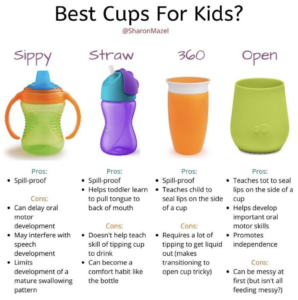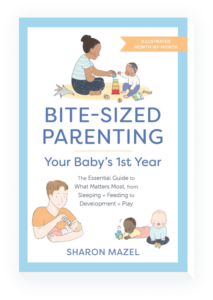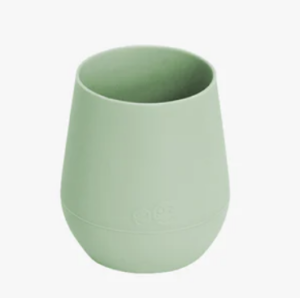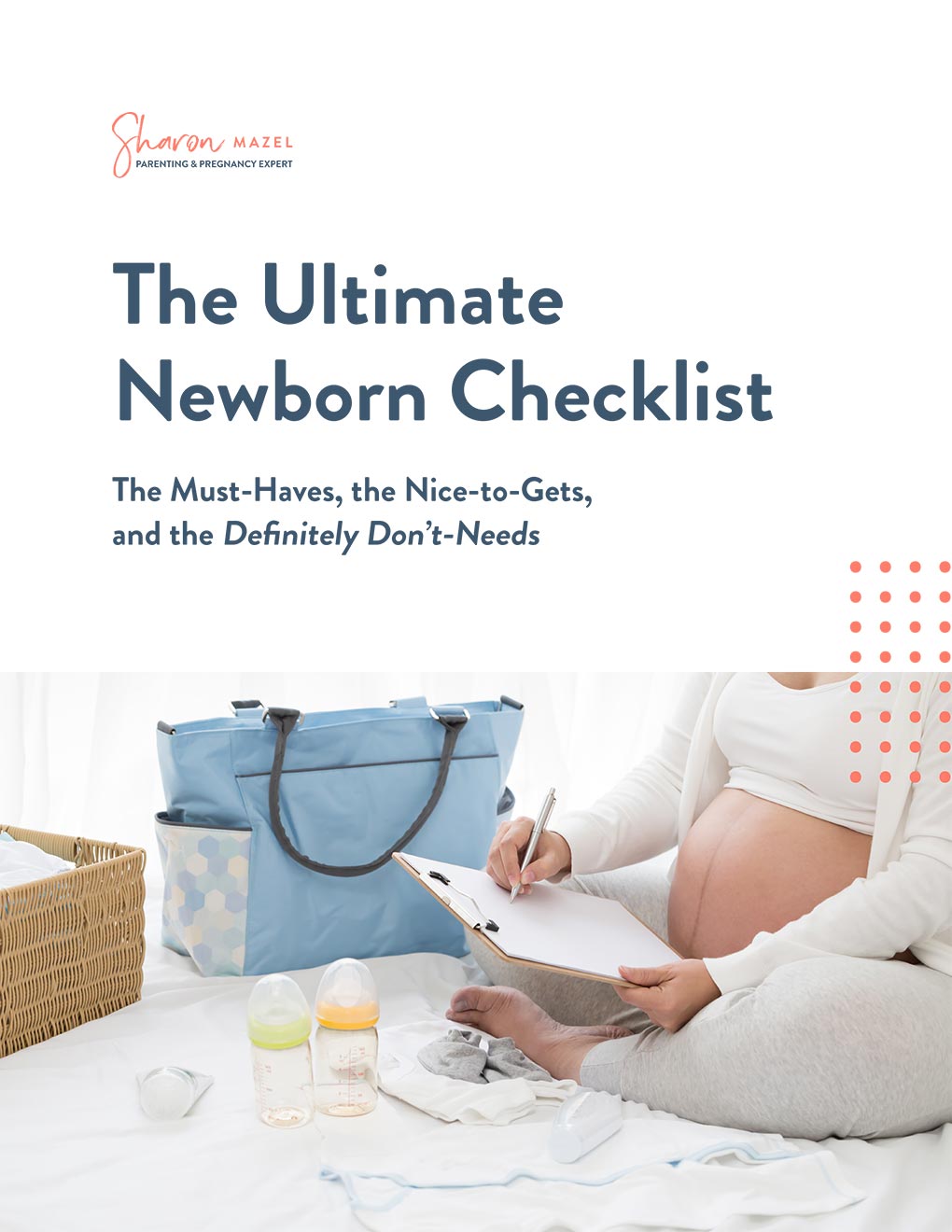Learn which baby cup is best for your little one and read about the pros and cons about open cups, straw cups, 360 cups, and sippy cups.
Experts recommend that you introduce a cup to your baby as soon as she starts solids — around 6 months old. The earlier in the first year that you introduce the cup, the better, so that your little one gets the drinking practice she needs. Remember, you’ll be weaning your cutie from the bottle by 12 to 15 months, so she’ll need to be proficient in the cup by that age. Introducing the cup early will help make for a much smoother transition when it’s time to bid the bottle bye-bye.
Is one type of baby cup better than the other?
There are clear winners in the baby cup game, with most experts recommending that you limit use of a sippy cup and turn instead to an open cup or straw cup for most of baby’s drinking. But because there are some advantages to the other styles of cups for baby, you can certainly add the 360 cup or sippy cup to the mix. In fact, using a variety of different cup styles may help promote optimal oral motor development. Be sure, however, to limit the use of the non-open cups to reduce the effects of some of their pitfalls. And certainly, by the time your baby is well into the second year, it will be a good idea to ditch the sippy and 360 cup altogether. Here’s the low down on the different types of cups for baby.
What to know about the open cup
The open cup should be the cup of choice for your baby… and you can start teaching your baby how to use one right from the start. The reason most pediatricians, speech-language pathologists, and developmental experts recommend the open cup over any other variety is because it has the fewest downsides (yes… it’s messy) with plenty of upsides.
An open cup helps your baby develop important oral motor skills (and it does so better than any other cup style), it teaches your baby how to seal her lips around the sides of a cup (a crucial skill for the rest of her life), and it promotes independence — something that you should be encouraging.
Click here for my recommended open cups.
What to know about the straw cup
Some babies are able to master drinking from a straw as early as 6 months old, while others don’t have the coordination needed for proficiency with the straw until closer to 8 or 9 months old or even later.
There are plenty of pros to a straw cup, which is why experts consider it the second best type of baby cup to introduce. It’s mostly spill proof, so if you’re worried about a mess, especially on the go, it’s a great option. The straw cup helps build lip, cheek, and tongue strength, and it also helps a baby learn how to pull her tongue to the back of her mouth, a skill needed for speech development and proper swallowing patterns. And if you think about it, those straw drinking muscles are the same ones babies use to manipulate food around their mouths, so working out those muscles is laying the foundation for excellent eating abilities as well.
There are some cons to the straw cup, however. Using one doesn’t teach the skill of tipping a cup to drink. And, as you’ll read below about a sippy cup, a straw cup can become a comfort habit (similar to a bottle), making it harder to wean your little one from the straw cup to an open cup.
Click here for my recommended straw cups.
What to know about the 360 cup
This type of cup is a spill-proof open cup with a lid, and because it teaches your baby to seal his lip on the side of the cup, it can be a good bridge between a sippy cup and a regular open cup.
But there are some pitfalls to the 360 cup. It requires a lot of tipping to extract liquid, plus it encourages your baby to bite down and suck out the liquid instead of sip it out — and sipping is the skill that is needed for drinking from an open cup. Another downside: the inner rim of this type of baby cup often gets gunky.
What to know about the sippy cup
The sippy cup has only one advantage: It’s spill-proof. Unfortunately, that positive does not outweigh the many negatives to sippy cup use, which is why most experts recommend that you don’t choose a sippy cup (or if you do, that you limit its use to very occasionally).
What are some of the cons of using a sippy cup?
The reason for the strong rebuke of the sippy? A sippy cup is really just a bottle in the sense that it doesn’t teach any new oral skills. As with a bottle, a baby forms a seal on the sippy cup spout by placing the tongue at the front of the mouth and then sucks out the liquid — and that doesn’t teach anything about sipping or promote oral motor development. In fact, prolonged use of the sippy cup has been shown to delay oral motor development, impact speech development, and lead to tooth decay (because of the pooled liquids in the mouth). It also limits the development of a mature swallowing pattern, plus it can end up being used as a comfort object much in the way a bottle might, causing too much liquid intake and drowning the appetite for solid foods.
If, despite these sippy cup cons, you’re still set on using a sippy cup, it’s best to remove the spill-proof valve since it forces a baby to sip the liquid instead of suck it out as with a bottle (of course, then the one positive of the sippy cup — the no-spill aspect — is removed, making little reason to use one at all). Also, choose one with a soft spout instead of a hard spout because it’s more similar to a large straw.
Looking for more information about cups and teaching your baby how to drink from an open cup and straw cup? My book Bite-Sized Parenting: Your Baby’s First Year covers it all, including these cup topics! It’s THE parenting book you’ll turn to again and again, so be sure to add it to your parenting library.
And be sure to subscribe to my newsletter for even more parenting infomation, tips, and strategies.
Recommended open cups
Here are some of my favorite choices for open cups. Click through to buy!
Sharon Says: Love this tiny cup for beginners from ezpz. This cup is great for little learners. The soft silicone helps to protect those new little teeth and sensitive gums, it’s small enough to fit even the tiniest of hands, has an interior angle to help regulate the flow of water coming out, and a weighted base with “tactile bumps” to help with tipping. Can you say “buy now”?! This cup is great, comes in four cute colors, and is definitely a must have for your kitchen.
Cons: There are few cons to this cup… unless you’re looking for something bigger (it’s really meant for newbie learners).

Sharon Says: Teaching your baby to use an open cup may be a daunting task but these Tough to Tip Cups are designed with a wide, weighted base, that make them well… tough to tip. They are small in size and have a ridged design allowing little hands to grab onto them easily. They are made in the USA, BPA Free, and dishwasher safe.
Cons: These cups may be better for older toddlers because the hard plastic material makes it hard to pick up for little ones. While this cup may not be best suited for your tiniest tots, once they can grab a cup, I’d definitely pick a no-tip option like this (less mess, less stress!)
Sharon Says: Another great option in the hard to tip cup family is this one by BABYBJÖRN. This cup is easy to hold, has a weighted bottom that makes it hard to tip, and comes in four adorable pastel colors. This cup is BPA free and is safe for freezers, microwaves, and dishwashers! I am a big fan of this cup for babies over 6 months, and as an added bonus, these pair perfectly with their plates and utensils for your newest little dinner guest!
Cons: While the bottom isn’t heavily weighted (perhaps as much as you’d like), the wide bottoms still make it hard for these cups to tip.
Sharon Says: This cup is not only super cute with two little handles for those little hands, but it’s also designed with 100% plant-based plastic. This cup is great for toddlers learning to sip independently — the handles allow them to easily hold tight, and the wide base makes this cup difficult to tip over. And don’t forget, the silicone material makes it unbreakable!
Cons: You may notice a funky smell when you first get the cups (that’s not unusual for plastic or silicone cups)–it’ll fade pretty soon. And since it’s so soft-sided, beware if your tot is a squeezer.
Sharon Says: These bamboo cups for baby are safe, degradable, stackable, and sustainable. They’re considered non-toxic and green, which will make you feel great about offering these cups to your little one. They come in a 6-pack filled with adorable colored open cups that easily stack for simple storage. They’re also freezer and dishwasher safe.
Cons: The bamboo material may make these cups slightly slippery for kids, so be sure to use once your little sipper is more of a sippy pro.
Sharon Says: These cups are perfectly sized “big kids” cups that fit well into little hands. They have a wide bottom to keep them stable on the table, are dishwasher safe, and match other Munchkin dishware so your little one can dine in style!
Cons: Not much downside to these cups other than your tot might find them a little slippery.
Sharon Says: These mini cups for baby are great for newbie open cup drinkers. They’re only 1.5 ounces, making them the perfect size for new cup learners. This award-winning cup with its wide opening helps to encourage proper sipping. Plus this four pack of fun colored cups is an awesome addition to your baby’s dining set.
Cons: The main con for this cup is also the pro: the size. The 1.5 oz size means it’s very small, holding only a little amount of liquid. It’s great for those tiny hands, but you may get tired of filling up their cup as they signal for more!
Recommended straw cups
Here are some of my favorite choices for straw cups. Click through to buy!
Sharon Says: Designed by a pediatric feeding specialist, this straw cup has sensory bumps to the straw itself to keep baby’s lips at the tip of the straw. Plus, its weighted base and tactile bumps provide topple resistance, something you’ll welcome with your newbie drinker. Made from food-grade silicone that’s BPA, BPS, PVC, latex and phthalate free, this ezpz cup is the perfect starter cup for straw drinkers!
Cons: Not really a con, but keep in mind how small this cup is! It’s made for little hands. Luckily, ezpz also makes a larger sized Happy Cup + Straw for older babies and toddlers.
Elk and Friends Glass Straw Cup
Sharon Says: This adorable set of four glass mason jars, nearly-leak-proof lids, silicone sleeves, and silicone straws is a real winner (and you can also get their stainless steel version if you prefer!). With stoppers on the straw, you’ll never have to worry about your little one pulling the straw out. And as a bonus, the lids also have a spout, so your cutie can drink from these cups even without the straw!
Cons: These cups will leak small amounts if your tot turns it completely upside down. Plus, the inner seal is just one more thing to have to wash!
Munchkin Cool Cat Stainless Steel Straw Cup
Sharon Says: Tots will love to pop this top to get to the straw on this stainless steel cup. It’s spill proof and insulated, keeping drinks cold for up to 15 hours! The handles make it easy to tote on the go.
Cons: These straws require a bit of suction to extract the liquid, so it may take some time for some new drinkers to get the hang of it.
Sharon Says: This straw cup grows with your little one — just take away the removable handles and continue to use this cup as your child’s drinking skills improve. This cup also has a unique almond shaped straw that opens upon mouth contact and a hinged cap that creates a leak proof top.
Cons: This may not be the best option for younger babies learning how to drink from a straw for the first time because it can be difficult to get liquid out of the straw. But once your little one is straw proficient, it’s a good option.
Munchkin Any Angle Click Lock Weighted Straw Trainer Cup
Sharon Says: Great for little ones on the go, this weighted straw moves with the cup, allowing your little one to drink at whatever angle: upside down, rightside up, or rolling on the ground! The cup comes with handles for an easy grasp and a flip top to close it when not taking a sip. The top also has a special click lock technology to make it spill proof.
Cons: The parts to this cup may not be the easiest to clean, but a few extra minutes at the sink might be worth it for no spills!
Nuby 2-Pack No-Spill Clik-It Cups with Flex Straw
Sharon Says: The Nuby is another great spill-proof straw cup option for your little one. When you turn the lid and hear the click, you know it is ready to be used! The soft silicone straw is gentle on those teething gums and just a light amount of pressure allows for your tot to suck easily (it also has a one piece valve straw which is easier to clean!). It has a unique design that allows for little hands to grip tightly and comes in fun color combinations!
Cons: “Leak-proof” doesn’t always mean 100% leak proof and this cup might not meet those standards. You also may not get to choose your color combos when ordering, which could totally mess up your dishware vibe!
Pura Kika Stainless Steel Insulated Water Bottle
Sharon Says: While this cup is on the slightly more expensive side, it’ll keep your little one’s drink cold (or warm) for hours! It also has the ability to be a baby bottle, toddler sippy cup, and kids water bottle with different tops (sold separately). This cup is also perfect if you’re looking for a plastic-free alternative.
Cons: Like most straw cups on this list, this cup, too, may be a little difficult to drink from.
Sharon Says: Is your baby having a hard time learning how to drink from a straw cup? This squeezable straw cup is a good teaching tool. Simply place the straw in your baby’s mouth and gently squeeze the cup to shoot a small amount of liquid inside. Your little one will catch on quickly and learn to suck on the straw herself.
Cons: The straw might be a bit too long for some little mouths.
I may earn commissions from purchases you make using my links. But you don’t pay any extra and this doesn’t affect which products I recommend.

















